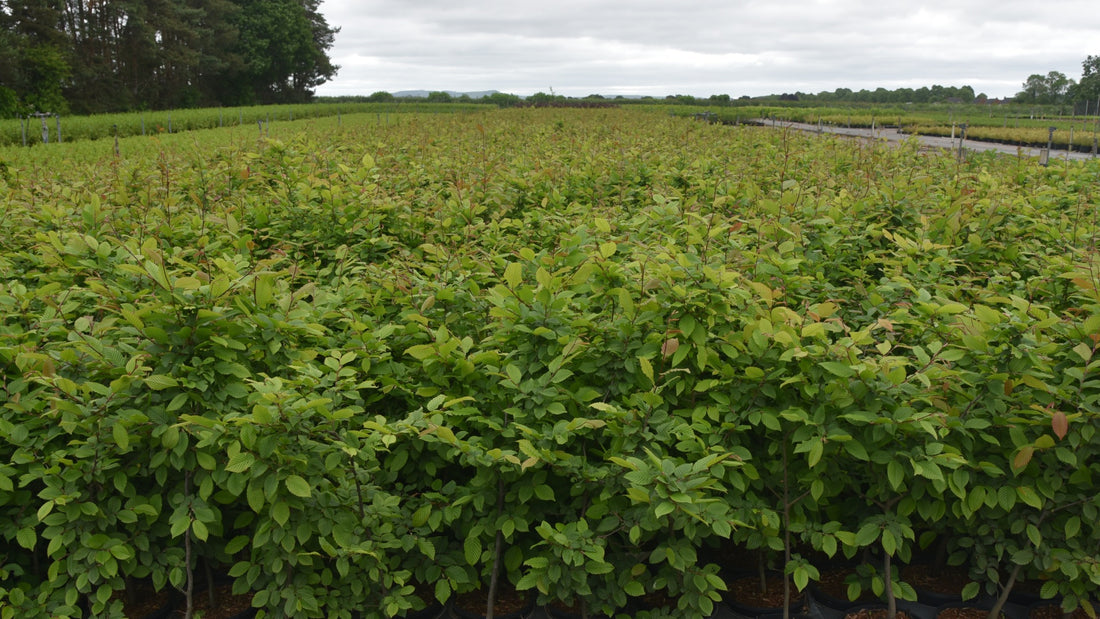
The Resilience of Hornbeam
Share
As the climate continues to change, gardeners and landscapers in the UK are increasingly seeking tree species that can withstand new and challenging environmental conditions. Beech (Fagus sylvatica), a traditional favorite, has been a cornerstone of British woodlands and hedging for centuries. However, hornbeam as a hedging plant (Carpinus betulus) is emerging as a more resilient successor due to its superior resistance to the evolving climate. This article explores why hornbeam is becoming the preferred choice.
Climate Challenge: Hornbeam vs Beech
Changing Weather Patterns
The UK climate has been experiencing significant shifts, including hotter summers, milder winters, and more erratic weather patterns. These changes have profound effects on native vegetation, particularly on species like beech, which thrive in specific climatic conditions.
Impact on Beech Trees
Beech trees, although majestic and culturally significant, are increasingly stressed by these changing conditions. They are particularly vulnerable to:
- Drought Stress: Beech trees have shallow root systems, making them susceptible to drought. Extended periods of dry weather, especially during the critical growing season, can lead to significant stress, reduced growth, and even mortality.
- Pests and Diseases: Climate change has led to the proliferation of pests and diseases that affect beech trees, such as beech bark disease and root rot, which thrive in warmer, wetter conditions.
- Storm Damage: Increased frequency of storms and heavy winds can cause physical damage to the shallow-rooted beech, leading to uprooting and breakage.
Why Hornbeam?
Hornbeam, a native tree of the UK, has demonstrated several characteristics that make it more adaptable to the current and projected climate conditions.
Deep Root System
Unlike beech, hornbeam has a deeper root system, allowing it to access water from lower soil levels. This trait is particularly beneficial during prolonged dry spells, providing a more reliable water supply and reducing drought stress. Hornbeam, as a hedging plant, benefits greatly from this trait when compared to Beech because hedgerows develop smaller root systems than isolated trees.
Greater Tolerance to Wet Conditions
Hornbeam is highly adaptable to different soil types and moisture levels. It can tolerate wetter conditions better than beech, which is increasingly important as the UK experiences more intense rainfall and potential flooding events.
Disease and Pest Resistance
Hornbeam is generally more resistant to many pests and diseases that are affecting beech trees. Its robust nature makes it less susceptible to common tree ailments, thus ensuring longevity and health even as environmental pressures mount.
Robustness Against Physical Damage
Hornbeam wood is exceptionally hard and durable, making it more resistant to wind and storm damage. This physical resilience means hornbeam is less likely to suffer from breakage or uprooting during severe weather events. As a hedging plant this also makes Hornbeam better protected against collisions.
Research Findings
Forest Research Institute Study
A study conducted by the Forest Research Institute examined the performance of beech and hornbeam under simulated future climate conditions. The findings highlighted hornbeam’s superior resilience to both drought and waterlogged conditions compared to beech. The study concluded that hornbeam’s adaptability makes it a more viable species for future-proofing UK woodlands.
National Trust Planting Projects
The National Trust has initiated several projects focusing on planting hornbeam as a replacement for beech in areas heavily affected by climate change. In the Wimpole Estate, Cambridgeshire, hornbeam has been planted to replace failing beech trees. Early results show promising growth rates and resilience, confirming hornbeam’s suitability for the changing climate.
Urban Landscaping in London
Urban areas like London are increasingly incorporating hornbeam into their green spaces. The city's Trees for Cities initiative has documented the success of hornbeam in parks and roadside plantings, where its tolerance to both drought and poor air quality has made it a preferred choice over beech and other traditional species.
Practical Considerations for Gardeners and Landscapers
Planting and Maintenance
- Site Selection: Choose locations with well-drained soil, but hornbeam can adapt to a variety of conditions.
- Watering: While establishing, ensure regular watering, particularly during dry spells, but hornbeam will become more drought-tolerant over time.
- Pruning: Hornbeam responds well to pruning, making it ideal for hedges and formal shapes.
Landscape Integration
- Hedges: Hornbeam makes excellent hedges, providing dense foliage and privacy.
- Woodland Areas: Integrate hornbeam into woodlands to increase biodiversity and resilience.
- Urban Plantings: Use hornbeam in urban green spaces for its pollution tolerance and robustness.
Conclusion
As the UK faces increasingly unpredictable and challenging climate conditions, hornbeam as a hedging plant stands out as a resilient and adaptable successor to the beech tree. Its deeper root system, tolerance to varied moisture levels, resistance to pests and diseases, and robustness against physical damage make it a superior choice for future planting. Through careful selection and planting, gardeners, landscapers, and conservationists can help ensure the health and beauty of the UK’s green spaces in the face of changing weather patterns.



